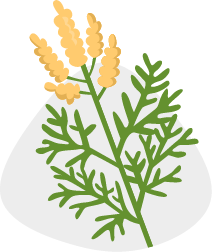Outdoor Allergy Symptoms, Triggers and Tips
Outdoor allergies have a specific set of triggers that exist primarily in the outdoor environment. Grass, tree and ragweed pollen as well as mold can often set off an allergy response when you spend time outdoors.
Here are some of the key signs you may have outdoor allergies.
Outdoor Allergy Symptoms
While outdoor allergies have a different set of allergens and triggers to indoor allergies, their symptoms are often similar. Some of the most common outdoor allergy symptoms include:
- Runny nose1
- Nasal congestion2
- Itchy eyes1
- Sneezing1
- Stuffy nose1
- Scratchy throat1
- Coughing2
- Postnasal drip2
If you start to notice any of these symptoms after spending long periods of time outside, such as a long walk or a picnic in the park, they could be signs of an outdoor allergy.
What Are Common Causes Of Outdoor Allergies?
There are several causes of outdoor allergies, most of which can be linked to seasonal allergens and triggers. Typically, the most common outdoor allergies are caused by pollen and mold. Here we take a look at the top allergens that could be behind your symptoms.
Tree pollen
Trees, like other plants, produce pollen, which some people may be allergic to3. Tree pollen is typically at its highest during the spring months, but in southern states, trees can start to release pollen into the air as early as January3. Because tree pollen is extremely fine, it is more likely to be blown about in the wind and find its way into the nose and eyes3.
Grass Pollen
Grass pollen is the most common allergy responsible for hay fever4. The grass pollen season hits its peak during late spring. So, if you notice your outdoor allergies getting worse between April and June, it could be that you have a grass allergy5.
Ragweed Pollen
Ragweed is another major cause of seasonal allergies, reaching its highest point in mid-September, although the pollen levels in some states starts to rise as early as June6. There are 17 different types of ragweed in 49 states across the US, any one of which could be behind your symptoms6.
Mold
Mold commonly grows on rotting logs, fallen leaves, grains and in compost piles7. When these areas are disturbed, mold spores are released into the air and can be breathed in by people in the area7. While most molds are not killed with the first frost of the year, they can become inactive during cooler months. However, some people still find their allergies are triggered all year round7.
TREE POLEN


GRASS POLLEN




RAGWEED POLLEN


MOLD

How To Avoid And Reduce Outdoor Allergy Symptoms
While outdoor allergy symptoms can be frustrating, there are plenty of ways you can manage them. We've put together our top allergy tips and tricks to help you get a handle on your outdoor allergies.
-
Plan your outdoor activities around pollen levels
Checking daily pollen counts and forecasts, and staying indoors when pollen levels are highest (generally between 10am and 5pm) can help you manage outdoor allergy symptoms. While pollen counts can vary depending upon the time of year, the weather, and other environmental factors, try to spend your time outdoors in the early morning when the pollen is usually at its lowest.
-
Get to know your triggers
You could try using an app such as Zyrtec® AllergyCast®* to keep track of your activities and daily symptoms – including the time of day when symptoms occur and what helps lessen them. This could help your doctor identify your triggers and help you better manage your symptoms.
-
Keep your home clean to help keep allergens out
Using an air filter can help maintain indoor air quality. Keeping your windows closed during the day can also help prevent outdoor allergens from coming inside.
If pollen does get into your home, you can keep on top of your allergies by cleaning regularly. Vacuum, dust and wash your soft furnishings – including curtains.
-
Change your clothes, shower and wash your hair
Once you’re done with your outdoor fun, put your clothes in the laundry basket, take a shower and wash your hair. This helps reduce the allergens you bring into your home by cleansing them from your body. It's also a good practice to shower before bed, keeping allergens out of your bedding.
-
Keep your furry friends groomed too
Pets, including cats and dogs, can carry pollen and mold on their coats, so bathing and grooming our furry friends can help keep allergen levels down. If your pet enjoys time outdoors, keeping them off your bed or out of your bedroom will help minimize both outdoor and pet allergens.
-
Use antihistamines
Antihistamines are designed to help reduce the effects of your allergy response to your triggers – whether that's pollen or mold. Our antihistamine products get to work quickly and provide long-lasting relief from your outdoor allergy symptoms, including runny nose, sneezing, itchy, watery eyes and itching of the nose or throat.
FAQs
What Are The Most Common Allergies In Adults?
Outdoor allergies are some of the most common types of allergy in adults. Pollen and mold are particularly common.
Why Have I Developed Seasonal Allergies?
Recently moving homes could be the cause of your sudden allergies. Certain pollens and molds are more common in some states than others, and these new higher levels of allergens could be triggering your immune response.
How Long Do Seasonal Allergies Last?
Seasonal allergies usually last for two to three weeks before the pollen levels drop to a manageable level again8. Grass Pollen usually peaks from mid-May until July, while Ragweed season tends to cover the Fall months – especially September and October.
* Available for iPhone™ and Android™. Standard data rates apply.
References:
- https://www.everydayhealth.com/allergy/indoor-and-outdoor-allergy-differ...
- https://www.mayoclinic.org/diseases-conditions/mold-allergy/symptoms-cau...
- https://community.aafa.org/blog/tree-pollen-spring-s-first-allergy-offender
- https://www.allergyuk.org/about/latest-news/1487-grass-pollen-and-hay-fever
- https://www.aaaai.org/tools-for-the-public/conditions-library/allergies/...
- https://community.aafa.org/blog/6-things-you-may-not-know-about-ragweed-...
- https://www.aafa.org/mold-allergy/#:~:text=What%20Are%20the%20Symptoms%2....
- https://www.aafa.org/rhinitis-nasal-allergy-hayfever


